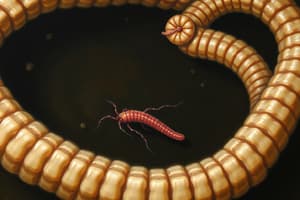Podcast
Questions and Answers
What is the main characteristics of the tracheal migration of infective larvae?
What is the main characteristics of the tracheal migration of infective larvae?
- Occurs following oral ingestion only.
- Is primarily a method of transmission during pregnancy.
- Involves migration through tissues to venules and then to lungs. (correct)
- Follows mucosal migration without prior circulation.
How long is the prepatent period for the development of parasites through oral ingestion?
How long is the prepatent period for the development of parasites through oral ingestion?
- 4 weeks
- 6 weeks
- 1 week
- 2 weeks (correct)
In which stage do larvae attach to the intestinal wall and begin to suck blood?
In which stage do larvae attach to the intestinal wall and begin to suck blood?
- Fourth stage (correct)
- First stage
- Mature stage
- Second stage
Which type of migration is characterized by larvae encysting in the tissues of adults?
Which type of migration is characterized by larvae encysting in the tissues of adults?
Which of the following transmission methods is more common for puppies?
Which of the following transmission methods is more common for puppies?
What is the approximate prepatent period for transmammary transmission in neonates?
What is the approximate prepatent period for transmammary transmission in neonates?
Which migration allows for both transplacental and transmammary transmission?
Which migration allows for both transplacental and transmammary transmission?
What occurs during the tracheal migration phase?
What occurs during the tracheal migration phase?
What is larval leak in relation to hookworm life cycle?
What is larval leak in relation to hookworm life cycle?
Which clinical sign is indicative of skin penetration by hookworm larvae?
Which clinical sign is indicative of skin penetration by hookworm larvae?
During tracheal migration of hookworm larvae, which symptom is typically observed?
During tracheal migration of hookworm larvae, which symptom is typically observed?
What does the prepatent period refer to in the context of hookworm infections?
What does the prepatent period refer to in the context of hookworm infections?
What is a key factor in the severity of illness caused by intestinal infestation of hookworms?
What is a key factor in the severity of illness caused by intestinal infestation of hookworms?
Which of the following correctly describes the life cycle of hookworms in cats?
Which of the following correctly describes the life cycle of hookworms in cats?
What is a common method of larval transmission for hookworms in cats?
What is a common method of larval transmission for hookworms in cats?
What is the typical prepatent period for hookworms in cats?
What is the typical prepatent period for hookworms in cats?
Which statement about the migration process of hookworms is true?
Which statement about the migration process of hookworms is true?
How can environmental control effectively reduce hookworm transmission?
How can environmental control effectively reduce hookworm transmission?
Which anthelmintic is NOT suitable for the treatment of hookworms in adult cats?
Which anthelmintic is NOT suitable for the treatment of hookworms in adult cats?
Which of the following methods is effective in preventing hookworm infections in the environment?
Which of the following methods is effective in preventing hookworm infections in the environment?
What lifestyle modification can help reduce the risk of hookworm infection in cats?
What lifestyle modification can help reduce the risk of hookworm infection in cats?
What is a significant public health concern related to hookworms?
What is a significant public health concern related to hookworms?
Which option describes an appropriate treatment regimen for a neonate with suspected hookworm infection?
Which option describes an appropriate treatment regimen for a neonate with suspected hookworm infection?
What is the infective stage of the hookworm larvae?
What is the infective stage of the hookworm larvae?
What is the primary method of transmission of hookworm to puppies?
What is the primary method of transmission of hookworm to puppies?
Which of the following describes the prepatent period for skin penetration of hookworm larvae?
Which of the following describes the prepatent period for skin penetration of hookworm larvae?
What environmental condition is critical for the survival of hookworm larvae?
What environmental condition is critical for the survival of hookworm larvae?
Which migration pathway is associated with the mucosal migration of hookworms?
Which migration pathway is associated with the mucosal migration of hookworms?
How long can the larvae of hookworms live as free-living organisms?
How long can the larvae of hookworms live as free-living organisms?
What characteristic is typical of strongyle-type eggs produced by hookworms?
What characteristic is typical of strongyle-type eggs produced by hookworms?
What is the typical duration for the development of 3rd stage larvae under favorable conditions?
What is the typical duration for the development of 3rd stage larvae under favorable conditions?
Which of the following constitutes a mode of larval transmission for hookworms?
Which of the following constitutes a mode of larval transmission for hookworms?
Which factor tends to make larvae susceptible during their life stages?
Which factor tends to make larvae susceptible during their life stages?
Flashcards
Intestinal Migration
Intestinal Migration
Larvae ingested, penetrate gut lining, develop to 4th stage, then mature while attached to intestinal wall, sucking blood.
Tracheal Migration
Tracheal Migration
Larvae penetrate skin, travel via circulation to lungs, then up trachea to be swallowed for maturation in the small intestine.
Somatic Migration
Somatic Migration
Larvae penetrate skin, encyst in tissues, may be reactivated, then travel to placenta, or mammary glands to be passed to neonates.
Transplacental Transmission
Transplacental Transmission
Signup and view all the flashcards
Transmammary Transmission
Transmammary Transmission
Signup and view all the flashcards
Prepatent Period (Intestinal)
Prepatent Period (Intestinal)
Signup and view all the flashcards
Prepatent Period (Tracheal)
Prepatent Period (Tracheal)
Signup and view all the flashcards
Prepatent Period (Somatic, Transplacental and Transmammary)
Prepatent Period (Somatic, Transplacental and Transmammary)
Signup and view all the flashcards
Anthelmintic for Cats
Anthelmintic for Cats
Signup and view all the flashcards
Hookworm Immunity in Adult Cats
Hookworm Immunity in Adult Cats
Signup and view all the flashcards
Neonate Hookworm Treatment
Neonate Hookworm Treatment
Signup and view all the flashcards
Environmental Control of Hookworms
Environmental Control of Hookworms
Signup and view all the flashcards
Sodium Borate for Hookworm Larvae
Sodium Borate for Hookworm Larvae
Signup and view all the flashcards
Bleach for Hookworm Larvae
Bleach for Hookworm Larvae
Signup and view all the flashcards
Preventive Measures for Hookworms
Preventive Measures for Hookworms
Signup and view all the flashcards
Cutaneous Larva Migrans (CLM)
Cutaneous Larva Migrans (CLM)
Signup and view all the flashcards
CLM Symptoms
CLM Symptoms
Signup and view all the flashcards
CLM Transmission
CLM Transmission
Signup and view all the flashcards
Hookworm Ova
Hookworm Ova
Signup and view all the flashcards
Hookworm Larvae
Hookworm Larvae
Signup and view all the flashcards
Larvae Infective Stage
Larvae Infective Stage
Signup and view all the flashcards
Oral Ingestion Transmission
Oral Ingestion Transmission
Signup and view all the flashcards
Skin Penetration Transmission
Skin Penetration Transmission
Signup and view all the flashcards
Prepatent Period
Prepatent Period
Signup and view all the flashcards
Mucosal Migration
Mucosal Migration
Signup and view all the flashcards
Larval Leak
Larval Leak
Signup and view all the flashcards
Hookworm Immunity
Hookworm Immunity
Signup and view all the flashcards
Clinical Signs of Skin Penetration
Clinical Signs of Skin Penetration
Signup and view all the flashcards
Hemoptysis
Hemoptysis
Signup and view all the flashcards
Hookworm Anemia
Hookworm Anemia
Signup and view all the flashcards
Study Notes
Hookworms
- Classified as nematodes in the Strongylidea family
- Their name derives from their characteristically curved head
- Species of importance include:
Ancylostoma caninum
- Most common hookworm of dogs
- Sometimes called "southern" hookworm
- Also found in foxes, coyotes, wolves, raccoons, and badgers
- Highly pathogenic
- Zoonotic
Ancylostoma tubaeforme
- Most common hookworm of domestic cats and other wild felids
- Zoonotic
Ancylostoma braziliense
- Affects dogs and cats
- Zoonotic
Uncinaria stenocephala
- Also known as "northern" hookworm
- Found in dogs in North America and Canada
- Can occasionally be found in cats
- Found in foxes, coyotes, and wolves
- Less pathogenic than other Ancylostoma species
- Not zoonotic
Necator americanus & Ancylostoma duodenale
- Human hookworms
General Information
- Life cycle is similar to other roundworms, often indirect transmission
- Adults reside in the small intestine of the host
- Males are typically smaller than females
- Adults have cutting plates/teeth to suck blood
- Hookworm eggs are characteristically strongyloid-type, containing multiple cells within the egg shell
- Larval development is initiated in the host's feces, with later stages occurring in soil, where they mature.
- Third-stage larvae (L3) are infective
- Transmission methods include oral ingestion of L3 larvae and penetration of skin by L3 larvae
- Prepatent periods vary depending on transmission methods, ranging from 2 to 9 weeks.
- Larvae are susceptible to desiccation.
- Larvae prefer warm temperatures
Migrations
- Mucosal migration: L3 larvae penetrate the small intestine mucosa, reaching maturity
- Tracheal migration: L3 larvae penetrate skin, travel through tissues to the lungs, then the trachea, and are swallowed
- Somatic migration: L3 larvae penetrate skin, enter the bloodstream, and travel to different organs, including the placenta or mammary glands
Clinical Signs
- Can result in itching, redness, or papular eruptions.
- Development of secondary bacterial infections
- Chronic illness in severe infestations can lead to anemia.
- Clinical signs vary depending on the stage of infection (skin, tracheal, or intestinal)
Diagnosis
- Fecal flotation can detect eggs, but egg counts don't always correlate with infection severity
- More important in neonates due to potentially shorter pre-patent periods
Treatment and Prevention
- Effective anthelmintic drugs are available
- Prevention measures include: sanitization, thorough cleaning of animal living areas and removal of feces promptly.
- Good hygiene and sanitation are crucial to prevent hookworm infestations in animals and prevent human exposure to hookworm larvae.
Public Health Significance
- Human hookworm larvae, like the Ancylostoma species, can penetrate human skin causing Cutaneous Larva Migrans (CLM).
- Symptoms of CLM include intense itching, redness, and swelling at the site of penetration.
Studying That Suits You
Use AI to generate personalized quizzes and flashcards to suit your learning preferences.




